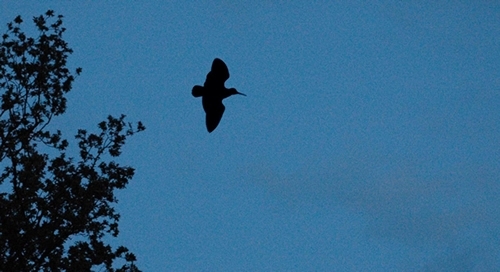by Andrew Hoodless, Head of Wetland Research, GWCT
Owing to the presence of several large blocks of diverse woodland at Rotherfield Park and, probably also, the fact that minimum tillage is employed with most of the crops, the estate supports large numbers of woodcock in winter.
Last winter, we ringed 149 woodcock as part of an ongoing study to quantify rates of wintering site fidelity. However, not all the woodcock are migrants and each summer we conduct counts of displaying males to provide an index of population status.

From late February, the unique roding call can be heard over the woods at dawn and dusk. Once the hubbub of blackbirds, song thrushes and robins laying claim to breeding territories has dwindled in the evening, a shrill whistle announces the woodcock’s dark silhouette above the canopy and its peculiar frog-like croaks can be heard as it passes overhead.
The ‘roding’ or display flights made by male woodcock are quite different from the rapid flights to and from cover at dawn and dusk in winter. Their purpose is the location of a receptive female with whom to mate and they consist of slow patrolling at tree-top height, announced by the unmistakeable call.
The term ‘roding’ comes from the Anglo-Saxon word ‘rode’ for a woodland ride, because the birds often seek out and follow rides and the edges of clearings. These are where the females will be waiting to get the males’ attention.
In March and early April, roding may only last 20-30 minutes, or barely take place at all on cold evenings, but from mid-May to early July the evening roding period lasts for about an hour.
 The conspicuous roding displays of male woodcock offer a unique opportunity to survey a species that is otherwise seldom seen in summer. However, early radio-tracking studies in the 1980s showed that woodcock males do not hold territories and do not pair for the breeding season in the way that most other waders and woodland birds do.
The conspicuous roding displays of male woodcock offer a unique opportunity to survey a species that is otherwise seldom seen in summer. However, early radio-tracking studies in the 1980s showed that woodcock males do not hold territories and do not pair for the breeding season in the way that most other waders and woodland birds do.
Instead, roding males patrol areas of suitable breeding habitat and older, more dominant birds obtain most matings with females. The male stays with a female only until she commences egg-laying and then resumes his crepuscular search for another female in his urge to pass on his genes. The female alone is responsible for incubating the eggs and rearing the young.
This potentially causes a problem with surveying woodcock because one or more woodcock may pass over the same point in a wood on a given evening. Our breakthrough came when we examined recordings of woodcock calls and found that each male has a slightly different, unique call.
This enabled us to demonstrate that the level of roding activity at a wood was related to the number of individual males and that counts of roding passes therefore provide an index for assessing trends in breeding numbers of this otherwise elusive and cryptic species.

Spectrographs of the roding calls of two woodcock. The first has four croak elements to
the call and a low frequency whistle, the other three croaks and a higher frequency whistle.
We have just finished our roding counts at Rotherfield and, as at other sites this year, the tally is down slightly on 2013 and 2014.
However, we still managed a count of 22 passes in one wood and breeding woodcock seem to be doing well at Rotherfield compared to many parts of southern England. The main change here in recent years has been in one wood where the birch has grown up and some thinning is probably required to improve the habitat for woodcock again.
Nationally, however, breeding woodcock are not faring well. Our 2013 survey with the British Trust for Ornithology suggested 22% occupancy of 1km squares containing more than 10ha of woodland, compared with 35% in 2003.
It is now particularly noticeable in southern England that sites occupied by breeding woodcock are clustered in areas with extensive blocks of woodland, such as the Forest of Dean, New Forest and Thetford Forest. We have started work to better understand the key habitat requirements of breeding woodcock and the factors driving the decline.